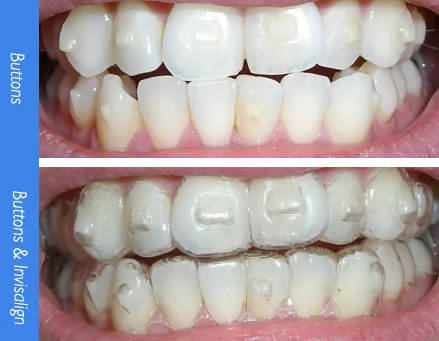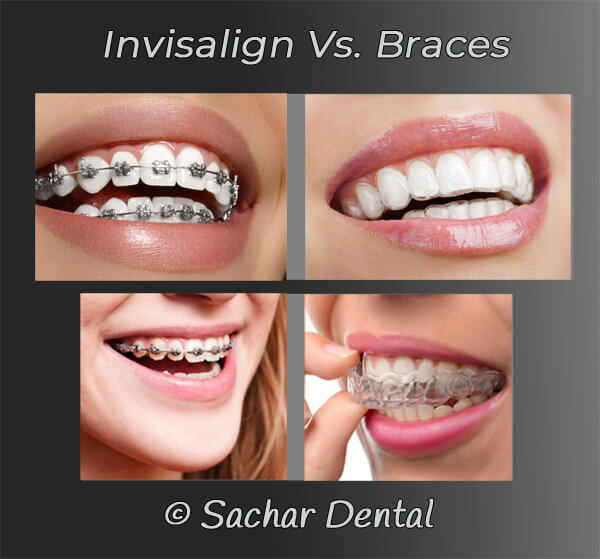Invisalign for Teens: A Modern Solution to Straightening Young Smiles
Invisalign for Teens: A Modern Solution to Straightening Young Smiles
Blog Article
Invisalign vs. Conventional Braces: Which Option Is Right for You?
When taking into consideration orthodontic therapy, the selection in between Invisalign and standard dental braces provides several vital factors that merit careful examination. Invisalign provides a discreet choice with removable aligners, while standard braces provide an extra visible yet effective remedy for serious misalignment.
Review of Treatment Options

On the other hand, typical dental braces consist of metal braces and cables that are bound to the teeth. This technique applies continual pressure gradually to attain positioning. While effective for intricate orthodontic concerns, standard dental braces require routine sees for modifications and can pose obstacles in preserving oral health due to the problem of cleaning about cords and braces.
Both alternatives have their benefits, and the option usually hinges on specific dental conditions, lifestyle preferences, and individual conformity. Eventually, consulting an orthodontic expert is vital for determining the most appropriate treatment plan tailored to private requirements. Recognizing the subtleties of each option can dramatically affect the overall success of orthodontic therapy.
Visual Considerations
A considerable factor affecting the selection between Invisalign and conventional dental braces is the visual appeal each therapy supplies. Invisalign aligners are crafted from clear plastic, making them essentially invisible when worn. This very discreet look is particularly appealing to teens and grownups that might really feel awkward concerning their orthodontic treatment. The capability to keep an all-natural smile throughout the alignment process can substantially boost the individual's self-confidence in social and professional setups.
On the other hand, standard braces contain metal brackets and cords, which can be extra recognizable. While innovations in orthodontic modern technology have brought about the development of smaller brackets and colored elastics, traditional braces still preserve an even more noticeable profile. For some people, the presence of dental braces may discourage them from looking for necessary therapy.
Ultimately, the choice between Invisalign and conventional braces might pivot on personal preferences regarding looks. Clients that focus on discernment typically lean toward Invisalign, while those who are less worried concerning visibility may choose conventional dental braces. Understanding the aesthetic implications of each option is essential for making a notified choice that lines up with one's way of life and choices.
Comfort and Convenience

In regards to comfort, Invisalign aligners are removable, enabling patients to appreciate their preferred foods without restriction and maintain optimum dental hygiene. Brushing and flossing are streamlined, as the aligners can be secured during these routines, whereas traditional dental braces need careful maneuvering around wires and braces.
In contrast, traditional braces necessitate normal modifications, making them less convenient for those with hectic schedules. In general, the convenience and convenience of Invisalign make it an attractive selection for many individuals seeking orthodontic therapy.
Therapy Period and Effectiveness
While both Invisalign and standard dental braces are effective in fixing oral imbalances, the period of therapy can differ substantially in between the two options. Commonly, Invisalign treatment can take anywhere from 12 to 18 months, depending on the complexity of the situation. The clear aligners function by progressively shifting teeth into their wanted positions, and routine follow-ups with an orthodontist assistance make certain progression remains on track.
In contrast, standard dental braces often require a longer commitment, typically ranging from 18 months to three years. This is because of their set nature and using braces and wires, which can be much more reliable for intricate instances and extreme imbalances (Invisalign). The treatment effectiveness of conventional braces is well-documented, as they enable specific adjustments and greater control over tooth activity
Ultimately, the selection in between Invisalign and standard braces may depend upon both the anticipated treatment period and the details oral problems available. Consulting with an orthodontist is vital, as they can give tailored suggestions based on private demands, guaranteeing the selected technique lines up with preferred results and timeframes.
Expense Comparison and Insurance Policy Options
Expense plays a considerable duty in the decision-making procedure for individuals like it considering orthodontic therapy, whether choosing Invisalign or conventional braces. Typically, the price of Invisalign varieties from $3,000 to $8,000, while traditional dental braces generally set you back in between $2,000 and $6,000. Variables affecting these costs consist of the intricacy of the situation, the duration of therapy, and geographical place.
Insurance insurance coverage can substantially impact out-of-pocket expenditures. Numerous dental insurance coverage plans supply partial coverage for orthodontic therapies, but the specifics can differ widely. It is critical for clients to review their insurance coverage to figure out the extent of insurance coverage for either option. Normally, conventional dental braces might be a lot more frequently covered by insurance coverage plans contrasted to Invisalign, which some insurance firms classify as an aesthetic treatment.
In addition, several orthodontic techniques provide adaptable layaway plan, making both treatment choices more moved here accessible. Individuals need to ask regarding possible funding alternatives and price cuts for ahead of time settlements. Assessing the overall price, consisting of insurance policy advantages and layaway plan, is vital for making an educated choice that straightens with both visual choices and spending plan factors to consider.

Conclusion
In summary, the choice between Invisalign and conventional braces rests on several aspects, consisting of visual choices, convenience, therapy period, and cost. Invisalign provides a very discreet, detachable option that facilitates oral health and nutritional adaptability, while typical braces might be preferable for complex dental issues and commonly come with a reduced rate factor. Inevitably, assessment with an orthodontist is important to evaluate individual situations and determine one of the most ideal therapy option for attaining optimum dental alignment.
When considering orthodontic therapy, the selection in between Invisalign and conventional dental braces offers a number of important factors look at here now that warrant cautious evaluation.Contrasting Invisalign and standard braces reveals distinctive treatment choices for orthodontic adjustment.While both Invisalign and traditional dental braces are efficient in fixing oral imbalances, the duration of therapy can vary significantly in between the two choices.Cost plays a considerable role in the decision-making procedure for individuals taking into consideration orthodontic treatment, whether deciding for Invisalign or conventional braces.In summary, the option between Invisalign and conventional braces pivots on multiple factors, consisting of aesthetic choices, comfort, treatment period, and price.
Report this page